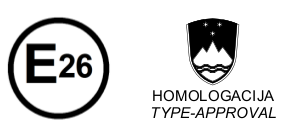Template:Emark description: Difference between revisions
Created page with "thumb|right|upright=0.35|300px Slovenian traffic safety agency (AVP) is a legal body of public law in the field of road safety, established on 1st Septe..." |
Atabasnikov (talk | contribs) |
||
| (5 intermediate revisions by 4 users not shown) | |||
| Line 1: | Line 1: | ||
[[File:E26 logo.png|thumb|right|upright=0.35|300px]] | [[File:E26 logo.png|thumb|right|upright=0.35|300px]] | ||
E-Mark is the regulations issued by the Economic Commission for Europe (referred to as ECE). | |||
==Description== | ==Description== | ||
According to the UN European Economic Commission regulations and the provisions of EU directives, in order to enter European market, cars, motorcycles and a variety of components and systems must be certified to meet the basic requirements of traffic safety and environmental protection. E-Mark and e-Mark are the European conformity marks issued by the transport sector, indicating that the products comply with relevant laws and regulations or directives. Vehicles and related products need to go through E-Mark certification process to be legally sold in Europe. | |||
There are currently 28 EU countries in ECE, in addition to EU member countries, including Eastern European, Southern European and other non-European countries. ECE regulations apply to all members is recommended, not mandatory standards. Member States may apply the ECE regulations, or continue to use their own regulations. E-Mark logo is a circular frame, means when the vehicle stop travel, the products must be used, for example: windshield, seat belts, headlights, and so on. Each EU member state has its own number of E-Mark certificate. | |||
Latest revision as of 16:40, 2 May 2019

E-Mark is the regulations issued by the Economic Commission for Europe (referred to as ECE).
Description
According to the UN European Economic Commission regulations and the provisions of EU directives, in order to enter European market, cars, motorcycles and a variety of components and systems must be certified to meet the basic requirements of traffic safety and environmental protection. E-Mark and e-Mark are the European conformity marks issued by the transport sector, indicating that the products comply with relevant laws and regulations or directives. Vehicles and related products need to go through E-Mark certification process to be legally sold in Europe.
There are currently 28 EU countries in ECE, in addition to EU member countries, including Eastern European, Southern European and other non-European countries. ECE regulations apply to all members is recommended, not mandatory standards. Member States may apply the ECE regulations, or continue to use their own regulations. E-Mark logo is a circular frame, means when the vehicle stop travel, the products must be used, for example: windshield, seat belts, headlights, and so on. Each EU member state has its own number of E-Mark certificate.
